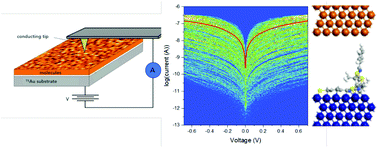Terphenylthiazole-based self-assembled monolayers on cobalt with high conductance photo-switching ratio for spintronics†
Abstract
Two new photo-switchable terphenylthiazole molecules are synthesized and self-assembled as monolayers on Au and on ferromagnetic Co electrodes. The electron transport properties probed by conductive atomic force microscopy in ultra-high vacuum reveal a larger conductance of the light-induced closed (c) form than for the open (o) form. We report an unprecedented conductance ratio of up to 380 between the closed and open forms on Co for the molecule with the anchoring group (thiol) on the side of the two N atoms of the thiazole unit. This result is rationalized by Density Functional Theory (DFT) calculations coupled to the Non-Equilibrium Green's function (NEGF) formalism. These calculations show that the high conductance in the closed form is due to a strong electronic coupling between the terphenylthiazole molecules and the Co electrode that manifests by a resonant transmission peak at the Fermi energy of the Co electrode with a large broadening. This behavior is not observed for the same molecules self-assembled on gold electrodes. These high conductance ratios make these Co-based molecular junctions attractive candidates to develop and study switchable molecular spintronic devices.



 Please wait while we load your content...
Please wait while we load your content...